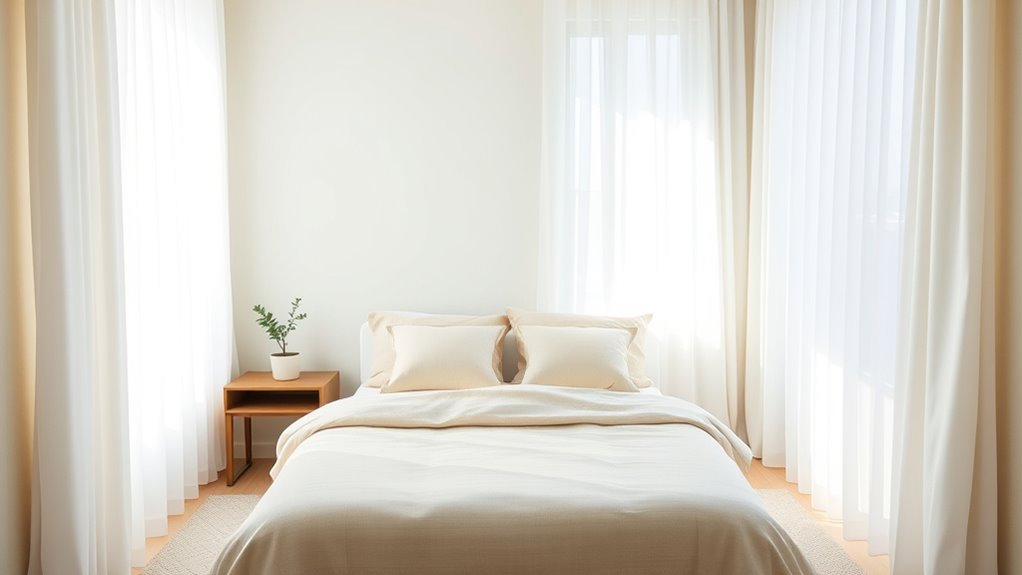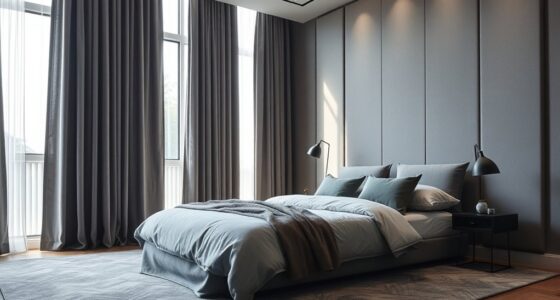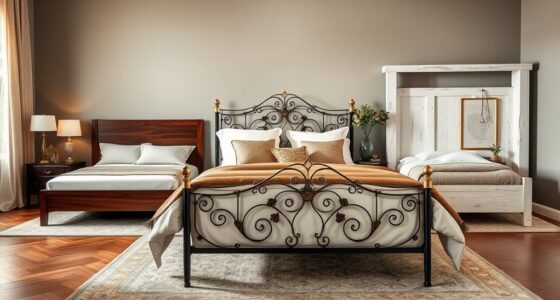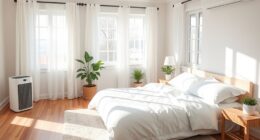To optimize your bedroom for restful sleep, position your bed against a solid wall away from windows and doors for security, and face it toward the door with a clear view to promote control. Use layered, soft lighting with dimmers to create a calm atmosphere, avoiding glare and harsh brightness. Keep the space clutter-free to enhance energy flow and serenity. Follow these principles, and you’ll discover simple ideas for turning your bedroom into a peaceful retreat.
Key Takeaways
- Position the bed against a solid wall with a clear view of the door to promote security and control.
- Keep the bed away from windows and doors to prevent drafts, noise, and disruptions.
- Incorporate layered, dimmable lighting with soft, warm tones to create a calming, relaxing environment.
- Minimize clutter and ensure open space to support smooth energy flow and visual clarity.
- Use strategic placement and lighting to enhance a tranquil atmosphere that promotes restful sleep.

Creating an optimized bedroom layout can considerably improve your comfort and functionality. One of the most important aspects is bed placement. You want to position your bed in a way that promotes restful sleep and fosters a sense of security. Ideally, place your bed against a solid wall, away from windows and doors, to minimize drafts and noise. This setup helps you feel grounded and protected, aligning with principles of good feng shui. Avoid placing your bed directly under a window or in line with the door, as these positions can disrupt your sleep due to drafts or sudden movements. Instead, find a spot where you have a clear view of the door without being directly in line with it, giving you a sense of control and calmness. This strategic placement not only improves sleep quality but also enhances the overall flow of energy within your space.
Lighting design plays a vital role in creating a peaceful environment conducive to rest. You should aim for layered lighting that can be easily adjusted based on your needs. Soft, warm lights are best for the bedroom, as they promote relaxation and help your body wind down at night. Use a combination of ambient lighting, such as ceiling fixtures or wall sconces, and task lighting, like bedside lamps, to give you flexibility. Dimmer switches are a great addition, allowing you to control the brightness and create a calming atmosphere when it’s time to sleep. Avoid harsh, bright lights, especially in the evening, as they can interfere with melatonin production and make it harder to fall asleep. Consider positioning your lighting fixtures so they don’t cast glare directly on your bed or mirror, which can disturb your rest and create visual clutter. Proper lighting design also involves minimizing clutter and ensuring your space feels open and inviting, encouraging a smooth flow of energy that supports relaxation.
Frequently Asked Questions
How Does Lighting Affect Bedroom Energy Flow?
Lighting notably impacts your bedroom’s energy flow. Natural light during the day boosts positive energy and keeps the space lively, while soft, warm artificial lighting in the evening creates a calming atmosphere that promotes restful sleep. Avoid harsh or bright lights before bed, as they can disrupt your natural energy flow. Instead, use dimmable lamps or candles to gently shift into a peaceful environment, enhancing your overall sleep quality.
Can Mirror Placement Influence Sleep Quality?
Mirror placement can substantially influence your sleep quality by impacting bedroom reflection and energy disturbance. If you position mirrors directly facing your bed, they may create restless energy or reflect negative vibes, disrupting your rest. Instead, place mirrors where they don’t reflect the bed or your sleeping area, ensuring they enhance positive energy flow and promote a peaceful environment. Proper mirror placement helps foster restful sleep and balanced bedroom energy.
What Are the Best Colors for Promoting Restful Sleep?
You should choose sleep-inducing shades like soft blues, gentle greens, and calming neutrals, as they promote relaxation through color psychology. These colors help reduce stress, lower heart rate, and create a peaceful environment for restful sleep. Avoid bright or stimulating hues like reds and oranges, which can increase energy. Incorporating these calming tones into your bedroom decor fosters a tranquil atmosphere that supports deep, restorative rest.
How Should I Arrange Furniture in a Small Bedroom?
Imagine transforming your small bedroom into a sanctuary. You should position your bed away from the door, ideally against a solid wall, while keeping pathways clear for flow. Tackle bedroom clutter by incorporating smart storage solutions like under-bed drawers or wall shelves. This arrangement maximizes space, promotes relaxation, and invites restful sleep. Don’t forget to keep furniture minimal—less is more when creating a calming, open environment in a small space.
Does Using Plants Improve Bedroom Feng Shui?
Using plants can improve your bedroom feng shui by enhancing indoor air quality and introducing natural elements that promote calmness. They help filter toxins and increase oxygen, creating a more restful environment. Choose easy-to-care-for plants like snake plants or peace lilies, and place them thoughtfully to balance energy flow. Incorporating these natural elements supports better sleep and a healthier, more harmonious space.
Conclusion
By applying simple feng shui principles, you can transform your bedroom into a restful retreat. Did you know that poor bedroom layout can disrupt sleep for up to 30% of adults? By optimizing your bed placement and decluttering, you boost relaxation and improve sleep quality. Take control of your space today—small changes make a big difference. Sleep better tonight and wake up refreshed, all by creating a flow that supports your well-being.









